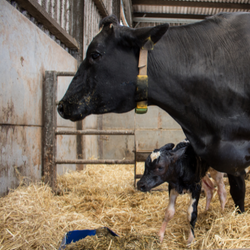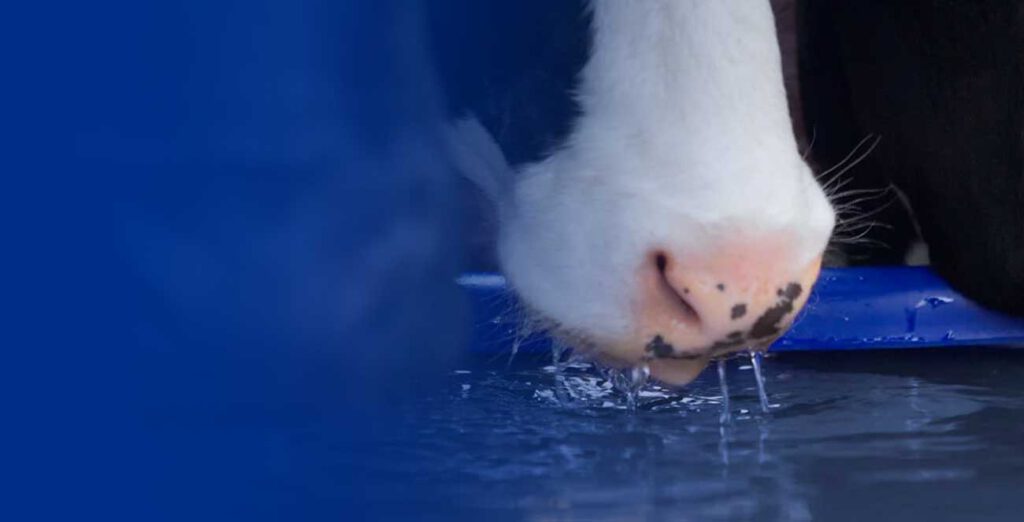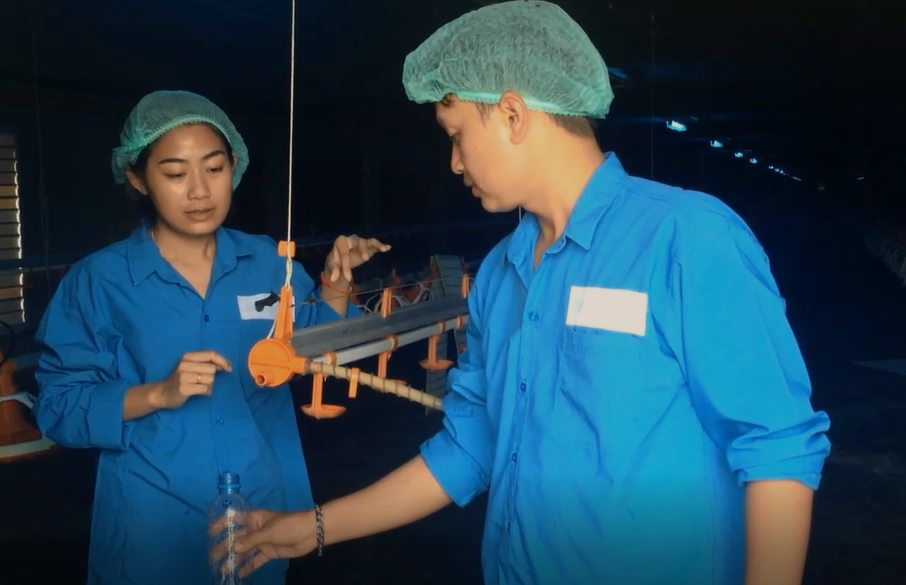Relieve heat stress in pigs with Aeroforte
Heat stress is a major issue in pig farming, since pigs do not sweat and have relatively small lungs. Combined with a high degree of insulating body fat, this makes them prone to heat stress: a condition where the internal temperature rises to a harmful level. To lower their temperature, pigs increase their respiration rate, reduce their feed intake and increase their water intake. This could cause diarrhoea and in severe cases death. Moreover, heat stress lowers fertility and disease resistance.
To help animals cope with high ambient temperatures, Kanters developed Aeroforte: a liquid supplement with essential oils to support the airways. These essential oils contain components with antibacterial, antiviral and anti-inflammatory effects, leading to breakdown of mucus in the airways and suppression of cough. These effects lead to a cool sensation and freer breathing.
Trial set-up
During 2021, Kanters conducted two trials in cooperation with Serket, a technology company looking to further develop their artificial intelligence using camera vision to enhance farm operations in real-time.
In 3 units on a commercial fattening pig farm, behaviour of the pigs was observed by a Kanters researcher in 2 pens. Each unit received a different treatment: Aeroforte continuously in the drinking water, Aeroforte fogged twice a day for 20 minutes and a control.
Behaviours observed were eating, drinking, lying down and walking. Lying down was broken down in lateral, half-lateral and sternal. Also whether the pigs lay down on the slatted part or solid part of the floor was noted.
Results and discussion
First trial
The table below shows what percentage of pigs showed certain behaviours in the different treatment groups per day over the entire test period:
| Behaviours | Drinking water | Fogging | Control |
|---|---|---|---|
| Lying (%) | 73.6 | 76.4 | 75.0 |
| - Lateral (%) | 33.6 | 35.6 | 37.2 |
| - Half-Lateral (%) | 14.5 | 15.7 | 13.8 |
| - Sternal (%) | 25.6 | 25.1 | 24.0 |
| - Lying on slatted floor (%) | 61.4 | 60.0 | 65.8 |
| Eating (%) | 7.0 | 6.2 | 6.2 |
| Drinking (%) | 2.8 | 2.7 | 2.6 |
| Moving (%) | 10.7 | 8.0 | 9.6 |
Out of these results, Eating was shown more in the Drinking water group than the control group (P = 0,03), and Moving more often occurred in the Drinking water group than both other groups (P < 0,05). When animals experience heat-stress, they reduce their feed intake (Pearce et al., 2013) and overall activity (Collin et al., 2001) because this will decrease their heat production (Close and Mount, 1978) and an increased number of Eating and Moving sightings are in line with the pigs experiencing less heat stress.
The fraction of pigs lying laterally was lower in the Drinking water group compared to the control group (P = 0,05), and the percentage of pigs lying on the slatted part of the floor was lower both treatment groups compared to the control (P < 0,01). When ambient temperatures are high, pigs spend more time lying down (Blackshaw en Blackshaw, 1994), especially in a lateral position (i.e. on their sides) and on the slatted floor (Aarnink et al., 2001; Huyn et al., 2005). The observations of this trial point out that the pigs treated with either of the Aeroforte treatments were less affected by high temperatures.
Second trial
| Behaviours | Drinking water | Fogging | Control |
|---|---|---|---|
| Lying (%) | 78.5 | 76.9 | 79.9 |
| - Lateral (%) | 39.2 | 35.6 | 43.4 |
| - Half-Lateral (%) | 13.6 | 14.4 | 14.8 |
| - Sternal (%) | 25.7 | 26.9 | 21.8 |
| - Lying on slatted floor (%) | 64.9 | 58.2 | 63.0 |
| Eating (%) | 6.6 | 1.0 | 6.2 |
| Drinking (%) | 2.8 | 0.9 | 1.3 |
| Moving (%) | 3.6 | 4.2 | 2.9 |
Pigs in the Fogging group showed less Lying than the Control group (P = 0,048). Pigs in the Control group Moved less compared to both Aeroforte treatment groups (P < 0,02) and were more often seen Drinking than both treatment groups (P < 0,01). These These behavioral patterns of the control group fit with that they would be experiencing more heat stress (Blackshaw en Blackshaw, 1994; Collin et al., 2001).
Lying laterally and Lying sternally differed between all three units (P < 0,05) – indicating the Control group experienced most heat stress – as did Lying on the slatted floor (P < 0,04) – which would indicate the Drinking water group experience the most heat stress. However, pigs prefer lying against a wall – or substituting object – in general (Blackshaw, 1980), and most of the wall space was connected to the slatted floor, making it possible that the pigs just preferred lying against the wall and were indifferent about the type of floor.
Conclusion
These results show that Aeroforte has a cooling effect on pigs, which is visible in their behaviour.
Serket
Simultaneously, the six pens were monitored by camera’s and an A.I. model from Serket. They found similar trends in behaviour as our human observer, with the highest correlation being between temperature and lying. At the trial periods, their algorithm had an accuracy rate of 90-95% for identifying eating and drinking, and 80-85% for moving activity. The monitoring system was able to detect heat stress with 80-90% accuracy, contributing to improved animal welfare on the farm.
Do you want to know more about Serket’s technology? Visit their website https://www.serket-tech.com/
References
Aarnink, A. J., Schrama, J. W., Verheijen, R. J., & Stefanowska, J. (2001). Pen fouling in pig houses affected by temperature. In Livestock Environment VI, Proceedings of the 6th International Symposium 2001 (p. 180). American Society of Agricultural and Biological Engineers.
Blackshaw, J.K. (1980). “Environmental effects on lying behaviour and the use of trough space in weaned pigs.” Applied Animal Ethology 7(1), 281-286
Blackshaw, J. K., & Blackshaw, A. W. (1994). Shade-seeking and lying behaviour in pigs of mixed sex and age, with access to outside pens. Applied Animal Behaviour Science, 39(3-4), 249-257.
Close, W. H., & Mount, L. E. (1978). The effects of plane of nutrition and environmental temperature on the energy metabolism of the growing pig: 1. Heat loss and critical temperature. British Journal of Nutrition, 40(3), 413-421.
Huynh, T. T. T., Aarnink, A. J. A., Gerrits, W. J. J., Heetkamp, M. J. H., Canh, T. T., Spoolder, H. A. M., … & Verstegen, M. W. A. (2005). Thermal behaviour of growing pigs in response to high temperature and humidity. Applied animal behaviour science, 91(1-2), 1-16.
Kaczmarek, S. A., Bochenek, M., Samuelsson, A. C., & Rutkowski, A. (2015). Effects of glyceryl polyethylene glycol ricinoleate on nutrient utilisation and performance of broiler chickens. Archives of animal nutrition, 69(4), 285-296.
Pearce, S. C., Gabler, N. K., Ross, J. W., Escobar, J., Patience, J. F., Rhoads, R. P., & Baumgard, L. H. (2013). The effects of heat stress and plane of nutrition on metabolism in growing pigs. Journal of animal science, 91(5), 2108-2118.



